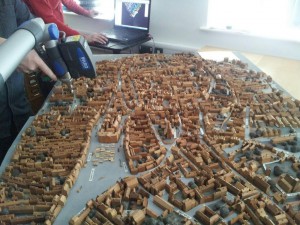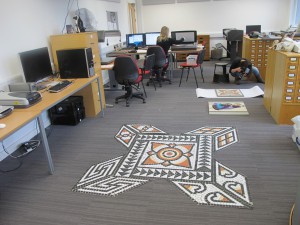
May 20, 2014, by Matt Davies
What is the Digital Humanities Centre?
The questions I get asked most as DHC Manager are ‘what is the DHC?’ and ‘how can it help me with my studies, teaching or research?’ Well in a nutshell the DHC is a space in which staff and students can use digital technology to enhance their work. We have seven workstations, each with its own Humanities themed name and its own unique set of equipment and software. Most comprise a PC and scanner (A3 or A4) and many have graphic creation and manipulation software including for instance; Adobe Photoshop, illustrator and InDesign, but there is also software for web design, video editing and 3D modelling; full details of what is available at each workstation can be found here. The DHC also has a remotely operated copy stand and camera, a PC linked 50” plasma TV for viewing (study related..!!) films and for practicing seminar presentations. We have graphics tabs, lap tops, digital projectors, and a small selection of DSLR and video cameras along with tripods, mics and a boom pole. There is an A zero scanner and printer which comes complete with its own A0team of operators who are on-hand two days a week to do any oversize scanning or printing required by customers, as well as to provide general help and advice to DHC users.
The star of the DHC show is the 3D scanner and like all stars it is glamorous and somewhat reclusive. This is because it is a hugely expensive and complicated piece of equipment which requires training and supervision, so is only available upon request and after its main keeper –Dr Katharina Lorenz –has been convinced of the worthiness of the project!
Perhaps it seems counter intuitive for a centre based around the digital but DHC also houses a resource that is almost militantly analogue. The Slide Collection comprises over 80,000+ 35mm slides and, like myself, travelled over to the DHC from Art History’s Visual Resource Centre (now the Archaeology Museum) It comprises fine arts, photography, sculpture, installation art, manuscripts, the Classics collection, archaeological excavations and an extensive and exclusive architecture collection donated to the University by Alec Dayton in 2000. Many HE and heritage institutions in the UK have been hasty in destroying their slide collections, I believe there are many good reasons for ensuring that some at least are saved and I will explore these in a future blog (hopefully there will soon be details of an ARLIS VRC campaign for a National Slide Collection too!) but for the time being allow me to posit that embracing the digital does not necessitate forgetting the analogue and that indeed, the two are not mutually exclusive.
Anyway, in terms of producing and manipulating digital resources the DHC pretty much has it all and there have already been a number of fantastic projects in here over the last couple of years so here are just a few examples to get you started:
Flatbed and slide scanners have been used to digitise; 35mm slides for an exhibition at Sheringham Park, vintage camera film, depictions of medieval stags as painted by local school kids (which are now used in National Trust brochures).
DSLR cameras have been used –often in conjunction with the copy stand- to photograph; archaeological finds, student work for the Classics department’s ISYP module, a selection of early twentieth century water colours painted by a Countess (also for an exhibition), events in and around the School and indeed beautiful portraits of members of staff -both academic and admin!
The 3D scanner has captured the digital likeness of; vases, sculptures, a wooden scale model of 19th century Nottingham, plaster moulds of the 18th century Lake District, engineering valves, human hands and a 30ft kayak! Yes I did just write 30ft kayak
Most recently the 3D scanner embarked on its most ambitious project yet when DHC resident artist James Smith put it through its paces scanning a live model! But I’ll let James tell you about that.
Perhaps most importantly it has become increasingly clear to us since its opening, that the DHC is also a social space in which skills, expertise and ideas are formed, developed and shared. Great projects, networks, and knowledge exchanges have been engendered via initiatives like the Student Volunteer Scheme, the Digital Interactions series of lunchtime talks, the Digital Asset Method research group, and by visiting external groups like the local history societies that fall under the Connected Communities umbrella. Many projects and collaborations have grown simply from conversations across the room or at events, or by people asking staff for help. Often we can help, sometimes we cannot, but –to coin a phrase – we always know a man or a woman who can, and quite often that man or woman will say “yes, I could help you to do it like that, but why not try this…?” or “perhaps this is something we could work on together…”
There are many more projects and events in the offing, not to mention the Digital Literacies for the Heritage Sector post graduate module which will be taught in DHC from Spring 2015, so watch this space – and please let me know if you have a digital Arts/Humanities project you’d like to collaborate on.



WOW! When I graduated in 1986 we had to rely on our feet and books to get the information we needed. I would have loved to have had the DHC as a resource during my time at Nottingham.